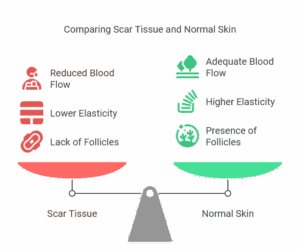A lot of people suffer head injuries from sports, at work, or due to random everyday accidents that leave them with a pronounced scar. This area will look like a bald patch, even if the surrounding hair grows out quite long, but unlike with typical male and female pattern hair loss, it can be anywhere on the head.
As scar tissue is different from regular skin, people often wonder if it’s even possible to use modern hair restoration techniques to patch up these bald spots. We will go into more detail on how scars differ from other parts of the scalp, the challenges involved in transplanting hair on them, and whether someone is a good candidate.
Can Hair Grow on Scars?
When the skin is damaged, the body’s natural healing process involves using collagen to close up the wound. However, as this protein fills up the wound, there is no place for the hair follicles and the blood vessels that feed them nutrients to be restored.
Because of the damage and limited blood flow in the scarred area, hair will never naturally grow back. However, there are surgical techniques that can help solve this problem.
Is a Hair Transplant on a Scar Possible?
There are several major issues that a surgeon must overcome when dealing with scars. Apart from the lack of follicles, this tissue is also thicker and less elastic than normal skin, with a different texture. This presents a challenge when trying to gauge the adequate depth for the incisions so that the hair grafts can be implanted properly.
However, as the transplanted hair follicles are fully contained as a unit and slowly grow their roots to reach the surrounding healthy blood vessels, a transplant is possible. You may need multiple operations to get the full results because of the reduced blood supply, and some surgeons also use corticosteroid injections to help level out the scar with the rest of the scalp.
Who Is a Good Candidate for a Hair Transplant on a Scar?
To ensure a successful transplant on scar tissue, the person should be in good general health and have plenty of viable hair in the donor area at the back of the head. If there are any active medical issues like psoriasis, you will need to wait for the flare-up to pass before you can get a transplant.
You may also want to consider getting different treatments like PRP, mesotherapy, nano fat grafting, and laser therapy first to help prepare the scar tissue and increase the chances of success. In general, most people can consider this procedure if the scar has healed properly.
Types of Scars Suitable for Hair Transplant
The scar must be stable, which means 8–12 months old and with no current inflammation.
Keloid formation, or the overactive collagen production during the healing phase, can also make the scar much thicker, appearing as a raised ridge, which reduces the success rate.
It also depends on the type of scarring you have. For example, surgical scars from the older Follicular Unit Transplantation (FUT) method and straight cuts have graft survival rates of just over 60%.
On the other hand, for burn scars that have been previously treated with nanofat injections or lasers, this number goes up to between 80% and 90%, while it’s typically just over 80% for laser-treated eyebrow scars.
With a little bit of preparation, you can expect good hair growth in the transplant area, often enough to hide the scar after a single operation.
Hair Transplant Procedures Used on Scars
As this type of tissue is a bit more challenging to work with and requires greater care, doctors typically recommend Follicular Unit Extraction (FUE). This is a method where follicular units are taken from the donor area one by one using a micro punch tool, and preserved in a special solution while the surgeon makes many tiny incisions in the recipient area, where the grafts are later implanted using forceps.
There are also advanced hair transplant techniques like Sapphire FUE, which uses a more precise blade, and the Micro Sapphire DHI, which combines the super-precise micro-incisions of the previous technique with the Choi Pen implantation method typically used in the standard DHI operation.
These options involve minimal damage to the scalp and give surgeons better control of the depth of the cut and the positioning of the grafts, which makes them perfect for use on scar tissue.
Challenges of Transplanting Hair into Scar Tissue
As mentioned, the typical FUE hair transplant requires the doctor to pierce through the scalp and make a microscopic opening at just the right depth for the donor grafts to take hold and connect to the underlying blood vessels.
If the scar has thickened and protrudes slightly from the surrounding skin, it can be difficult to get to the proper depth, at least not without previous interventions, like using corticosteroid injections to flatten it out. The doctor will also need to use a sturdier, specialised tool, like a knife with an artificial sapphire blade, and incorporate additional treatments like PRP sessions.
Also, if a lot of the new follicles cannot survive due to a lack of blood flow, you will need an additional surgery to properly fill out the area and help it blend in with the rest of the hair.

Find the Best Clinic for This Challenging Procedure
To get the best possible graft survival rates and hide your scar properly, you will need the help of experienced professionals from one of the best clinics. If you are looking for a high-quality hair transplant in Istanbul, with cutting-edge technology and the latest techniques, first look at the images of patients’ before and after results on the website.
A top clinic like Asli Tarcan will also have plenty of positive reviews and patient testimonials to back up their reputation, and a team of doctors with tens of thousands of successful operations under their belt. The best part is that you can get the highest level of care for a fraction of the price that US clinics charge.

